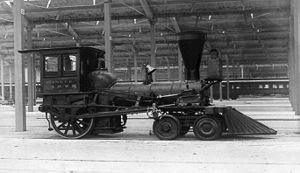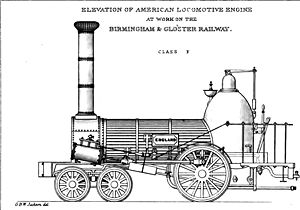
4-2-0
Encyclopedia

Whyte notation
The Whyte notation for classifying steam locomotives by wheel arrangement was devised by Frederick Methvan Whyte and came into use in the early twentieth century encouraged by an editorial in American Engineer and Railroad Journal...
for the classification of steam locomotive
Steam locomotive
A steam locomotive is a railway locomotive that produces its power through a steam engine. These locomotives are fueled by burning some combustible material, usually coal, wood or oil, to produce steam in a boiler, which drives the steam engine...
s, 4-2-0 represents the wheel arrangement
Wheel arrangement
In rail transport, a wheel arrangement is a system of classifying the way in which wheels are distributed beneath a locomotive.. Several notations exist to describe the wheel assemblies of a locomotive by type, position, and connections, with the adopted notations varying by country...
of four leading wheel
Leading wheel
The leading wheel or leading axle of a steam locomotive is an unpowered wheel or axle located in front of the driving wheels. The axle or axles of the leading wheels are normally located in a truck...
s on two axles, two powered and coupled driving wheel
Driving wheel
On a steam locomotive, a driving wheel is a powered wheel which is driven by the locomotive's pistons...
s on one axle, and no trailing wheel
Trailing wheel
On a steam locomotive, a trailing wheel or trailing axle is generally an unpowered wheel or axle located behind the driving wheels. The axle of the trailing wheels was usually located on a trailing truck...
s. This type of locomotive, often called a Jervis type, was common on American
United States
The United States of America is a federal constitutional republic comprising fifty states and a federal district...
railroads from the 1830s through the 1850s.
Other equivalent classifications are:
UIC classification
UIC classification
The UIC classification of locomotive axle arrangements describes the wheel arrangement of locomotives, multiple units and trams. It is set out in the International Union of Railways "Leaflet 650 - Standard designation of axle arrangement on locomotives and multiple-unit sets". It is used in much...
: 2′A (also known as German classification and Italian classification)
French classification: 210
Turkish classification
Turkish classification
In the Turkish classification system for railway locomotives, the number of powered axles are followed by the total number of axles. It is identical to the Swiss system except that the latter places a slash between the two numbers.Thus0-6-0 becomes 33...
: 13
Swiss classification: 1/3
History
The first 4-2-0 built was the Experiment (later named Brother Jonathan) for the Mohawk and Hudson Railroad in 1832. It was built by the West Point FoundryWest Point Foundry
The West Point Foundry was an early ironworks in Cold Spring, New York that operated from 1817 to 1911. Set up to remedy deficiencies in national armaments production after the War of 1812, it became most famous for its production of Parrott rifles and other munitions during the Civil War, although...
based on a design by John B. Jervis
John B. Jervis
John Bloomfield Jervis was an American civil engineer. He was America's leading consulting engineer of the antebellum era . Jervis was a pioneer in the development of canals and railroads for the expanding United States...
. Having little else to reference, the manufacturers patterned the boiler and valve gears after locomotives built by Robert Stephenson
Robert Stephenson
Robert Stephenson FRS was an English civil engineer. He was the only son of George Stephenson, the famed locomotive builder and railway engineer; many of the achievements popularly credited to his father were actually the joint efforts of father and son.-Early life :He was born on the 16th of...
of England.
In England, it had developed from the 2-2-2
2-2-2
Under the Whyte notation for the classification of steam locomotives, 2-2-2 represents the wheel arrangement of two leading wheels on one axle two powered driving wheels on one axle, and two trailing wheels on one axle. The wheel arrangement both provided more stability and enabled a larger firebox...
design of Stephenson's first Long Boiler locomotive
Long Boiler locomotive
The Long Boiler locomotive was the object of a patent by Robert Stephenson and the name became synonymous with the pattern.-History:It is generally perceived that it arose out of attempts to match the power of broad gauge locomotives within the limitations of the loading gauge of Stephenson railways...
, around 1840, which he had altered to place two pairs of wheels at the front with the outside cylinders between them to improve stability. A few examples of Stephenson locomotives were already in operation in America, so engineers did not have to travel too far to get their initial ideas.
In America
United States
The United States of America is a federal constitutional republic comprising fifty states and a federal district...
, the design was a modification of the 0-4-0
0-4-0
Under the Whyte notation for the classification of steam locomotives, 0-4-0 represents one of the simplest possible types, that with two axles and four coupled wheels, all of which are driven...
design then in common use. The 0-4-0 proved to be too rigid for the railroads of the day, often derailing on the tight curves and quick elevation changes of American railroads. For the 4-2-0, Jervis introduced a four-wheel leading truck under the locomotive's smokebox
Smokebox
A smokebox is one of the major basic parts of a Steam locomotive exhaust system. Smoke and hot gases pass from the firebox through tubes where they pass heat to the surrounding water in the boiler. The smoke then enters the smokebox, and is exhausted to the atmosphere through the chimney .To assist...
that swiveled independently from the main frame of the locomotive (in contrast to the English engines mentioned earlier, which had rigid frames). The pistons powered a single driving axle at the rear of the locomotive, just behind the firebox. This design resulted in a much more stable locomotive that was able to guide itself into curves more easily than the 0-4-0.
This design proved so effective on American railroads that many of the early 0-4-0s were rebuilt as 4-2-0s. The 4-2-0 excelled in its ability to stay on the track, especially those with single driving axles behind the firebox, whose main virtue was stability. But, with only one driving axle behind the smokebox, the locomotive's weight was spread over a small proportion of powered wheels, which meant its total power was substantially reduced. However, other 4-2-0 locomotives had the driving axle in front of the firebox, adhesive weight was increased.
One possible solution was one patented in 1834 by E. L. Miller and used extensively by Matthias W. Baldwin
Matthias W. Baldwin
Matthias William Baldwin was an American manufacturer of steam locomotives. He opened his machine shop in 1825...
, in which raising a pair of levers attached the tender frame to an extension of the locomotive frame, transferring some weight from the tender to the locomotive frame, making more weight available for adhesion.
However, an automatic version was patented in 1835 by and George E. Sellers and used extensively by Norris
William Norris (locomotive builder)
William Norris was an American steam locomotive builder. He founded the Norris Locomotive Works and through this company pioneered the use of the 4-2-0 locomotive type in America during the 1840s....
after he obtained rights to it. This system used a beam whose fulcrum was the driving axle. On flat and level surfaces, the beam was slightly raised. But at starting or on grades, the resistance made the beam assume a horizontal position, which caused the locomotive to tip upward. This plan placed more of the locomotive's weight on the driving axle, but by reducing the weight on the leading truck, also made it more prone to derailment
Derailment
A derailment is an accident on a railway or tramway in which a rail vehicle, or part or all of a train, leaves the tracks on which it is travelling, with consequent damage and in many cases injury and/or death....
s
A more practical solution, first put into production by Norris, moved the driving axle to a location on the frame in front of the locomotive's firebox. This was done because Baldwin refused to grant rights to Norris to use his patented "half-crank" arrangement. Cantilever
Cantilever
A cantilever is a beam anchored at only one end. The beam carries the load to the support where it is resisted by moment and shear stress. Cantilever construction allows for overhanging structures without external bracing. Cantilevers can also be constructed with trusses or slabs.This is in...
ing the weight of the firebox and the locomotive crew behind the driving axle placed more weight on the driving axle without substantially reducing the weight on the leading truck. However, Norris's design led to a shorter wheelbase, which tended to offset any gains in the tractive force
Tractive effort
As used in mechanical engineering, the term tractive force is the pulling or pushing force exerted by a vehicle on another vehicle or object. The term tractive effort is synonymous with tractive force, and is often used in railway engineering to describe the pulling or pushing capability of a...
on the driving axle by reducing the locomotive's overall stability.

Birmingham and Bristol Railway
The Birmingham and Bristol Railway was a short-lived railway company, formed in 1845 by the merger of the Birmingham and Gloucester Railway and the Bristol and Gloucester Railway.-Origin:...
since, because of the Lickey Incline
Lickey Incline
The Lickey Incline is the steepest sustained main-line railway incline in Great Britain and is situated south of Birmingham, in England. The climb is a gradient of 1-in-37.7 for a continuous distance of two miles ....
, British manufacturers declined to supply.
As the 1840s approached, and more American railroads were experimenting with the new 4-4-0
4-4-0
Under the Whyte notation for the classification of steam locomotives, 4-4-0 represents the wheel arrangement of four leading wheels on two axles , four powered and coupled driving wheels on two axles, and no trailing wheels...
locomotive type, the 4-2-0 fell out of favor as it was not as able to pull a paying load on the railroad as the 4-4-0. 4-2-0s were built into the 1850s, but their use was restricted to light-duty trains as most railroads by this time had found them unsuitable for regular work.
In England, for freight work, four-coupled and six-coupled engines were performing well. However, for passenger work, the aim was greater speed. Because of the fragility of cast-iron connecting rods, "singles" continued to be used, with the largest driving wheels possible.
For some reason, British manufacturers did not take up the idea of mounting the forward wheels on a bogie
Bogie
A bogie is a wheeled wagon or trolley. In mechanics terms, a bogie is a chassis or framework carrying wheels, attached to a vehicle. It can be fixed in place, as on a cargo truck, mounted on a swivel, as on a railway carriage/car or locomotive, or sprung as in the suspension of a caterpillar...
for some years. Possibly there were fears about their stability, but with a long rigid frame, greater speed was achieved at the cost of a very rough ride and damage to the track.
The culmination of this approach was seen in the Crampton locomotive
Crampton locomotive
A Crampton locomotive is a type of steam locomotive designed by Thomas Russell Crampton and built by various firms from 1846. The main British builders were Tulk and Ley and Robert Stephenson and Company....
where, to make the drivers as large as possible, they were mounted behind the firebox.
Once steel
Steel
Steel is an alloy that consists mostly of iron and has a carbon content between 0.2% and 2.1% by weight, depending on the grade. Carbon is the most common alloying material for iron, but various other alloying elements are used, such as manganese, chromium, vanadium, and tungsten...
became available, greater rotational speeds became possible with multiple, smaller coupled wheels.

